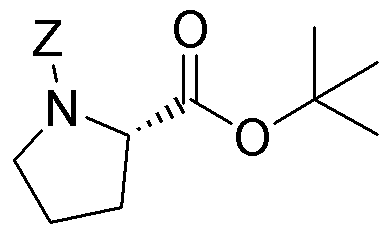Z-L-proline tert-butyl ester is widely utilized in research focused on:
- Peptide Synthesis: This compound serves as a valuable building block in the synthesis of peptides, particularly in the development of pharmaceuticals. Its unique structure allows for the formation of stable linkages, enhancing the efficiency of peptide assembly.
- Drug Development: In medicinal chemistry, it is used to create proline derivatives that can improve the bioavailability and efficacy of drug candidates, making it essential for researchers working on new therapeutic agents.
- Chiral Catalysis: The compound acts as a chiral auxiliary in asymmetric synthesis, helping chemists produce enantiomerically pure compounds. This is particularly beneficial in the production of chiral drugs, which often require high purity for effectiveness.
- Bioconjugation: It is employed in bioconjugation processes to attach biomolecules to surfaces or other molecules, facilitating the development of targeted drug delivery systems and diagnostic tools in biotechnology.
- Material Science: The compound finds applications in the development of polymers and materials, where its properties can enhance the performance and stability of the final products, making it valuable in industries such as coatings and adhesives.
Informations générales
Propriétés
Sécurité et réglementation
Applications
Z-L-proline tert-butyl ester is widely utilized in research focused on:
- Peptide Synthesis: This compound serves as a valuable building block in the synthesis of peptides, particularly in the development of pharmaceuticals. Its unique structure allows for the formation of stable linkages, enhancing the efficiency of peptide assembly.
- Drug Development: In medicinal chemistry, it is used to create proline derivatives that can improve the bioavailability and efficacy of drug candidates, making it essential for researchers working on new therapeutic agents.
- Chiral Catalysis: The compound acts as a chiral auxiliary in asymmetric synthesis, helping chemists produce enantiomerically pure compounds. This is particularly beneficial in the production of chiral drugs, which often require high purity for effectiveness.
- Bioconjugation: It is employed in bioconjugation processes to attach biomolecules to surfaces or other molecules, facilitating the development of targeted drug delivery systems and diagnostic tools in biotechnology.
- Material Science: The compound finds applications in the development of polymers and materials, where its properties can enhance the performance and stability of the final products, making it valuable in industries such as coatings and adhesives.
Documents
Fiches de données de sécurité (FDS)
La FDS fournit des informations de sécurité complètes sur la manipulation, le stockage et l’élimination du produit.
Spécifications du produit (PS)
Le PS fournit une description complète des propriétés du produit, notamment sa composition chimique, son état physique, sa pureté et les exigences de stockage. Il détaille également les plages de qualité acceptables et les applications prévues du produit.
Certificats d'analyse (COA)
Recherchez des certificats d'analyse (COA) en saisissant le numéro de lot du produit. Les numéros de lot et de lot se trouvent sur l'étiquette d'un produit, après les mots « Lot » ou « Lot de fabrication ».
Numéro de catalogue
Numéro de lot/série
Certificats d'origine (COO)
Ce certificat d'exploitation confirme le pays dans lequel le produit a été fabriqué, et détaille également les matériaux et composants utilisés et s'il est issu de sources naturelles, synthétiques ou autres sources spécifiques. Ce certificat peut être requis pour les douanes, le commerce et la conformité réglementaire.
Numéro de catalogue
Numéro de lot/série
Fiches de données de sécurité (FDS)
La FDS fournit des informations de sécurité complètes sur la manipulation, le stockage et l’élimination du produit.
DownloadSpécifications du produit (PS)
Le PS fournit une description complète des propriétés du produit, notamment sa composition chimique, son état physique, sa pureté et les exigences de stockage. Il détaille également les plages de qualité acceptables et les applications prévues du produit.
DownloadCertificats d'analyse (COA)
Recherchez des certificats d'analyse (COA) en saisissant le numéro de lot du produit. Les numéros de lot et de lot se trouvent sur l'étiquette d'un produit, après les mots « Lot » ou « Lot de fabrication ».
Numéro de catalogue
Numéro de lot/série
Certificats d'origine (COO)
Ce certificat d'exploitation confirme le pays dans lequel le produit a été fabriqué, et détaille également les matériaux et composants utilisés et s'il est issu de sources naturelles, synthétiques ou autres sources spécifiques. Ce certificat peut être requis pour les douanes, le commerce et la conformité réglementaire.


